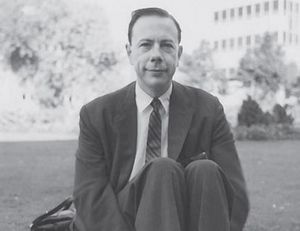
Back أندرو غليسون Arabic اندرو جليسون ARZ اندرو ام. قلیسون AZB অ্যান্ড্রু এম. গ্লিসন Bengali/Bangla Andrew Gleason Catalan Andrew Gleason German Andrew Gleason Spanish اندرو ام. گلیسون Persian Andrew M. Gleason French Andrew Gleason HT
Andrew M. Gleason | |
|---|---|
 Berlin, 1959 | |
| Born | November 4, 1921 |
| Died | October 17, 2008 (aged 86) |
| Alma mater | Yale University[3] |
| Known for |
|
| Spouse | |
| Awards |
|
| Scientific career | |
| Fields | Mathematics, cryptography |
| Institutions | Harvard University |
| Doctoral advisor | None |
| Other academic advisors | George Mackey[A] |
| Doctoral students | |
Andrew Mattei Gleason (1921–2008) was an American mathematician who made fundamental contributions to widely varied areas of mathematics, including the solution of Hilbert's fifth problem, and was a leader in reform and innovation in mathematics teaching at all levels.[4][5] Gleason's theorem in quantum logic and the Greenwood–Gleason graph, an important example in Ramsey theory, are named for him.
As a young World War II naval officer, Gleason broke German and Japanese military codes. After the war he spent his entire academic career at Harvard University, from which he retired in 1992. His numerous academic and scholarly leadership posts included chairmanship of the Harvard Mathematics Department and the Harvard Society of Fellows, and presidency of the American Mathematical Society. He continued to advise the United States government on cryptographic security, and the Commonwealth of Massachusetts on mathematics education for children, almost until the end of his life.
Gleason won the Newcomb Cleveland Prize in 1952 and the Gung–Hu Distinguished Service Award of the American Mathematical Society in 1996. He was a member of the National Academy of Sciences and of the American Philosophical Society, and held the Hollis Chair of Mathematics and Natural Philosophy at Harvard.
He was fond of saying that mathematical proofs "really aren't there to convince you that something is true—they're there to show you why it is true."[6] The Notices of the American Mathematical Society called him "one of the quiet giants of twentieth-century mathematics, the consummate professor dedicated to scholarship, teaching, and service in equal measure."[7]
- ^ Cite error: The named reference
palais-h5pwas invoked but never defined (see the help page). - ^ Elkins, Kimball C. (1958), "Honorary degrees at Harvard", Harvard Library Bulletin, 12 (3): 326–353. On pp. 327–328, Elkins writes "There is another type of degree, however, that must be classified as honorary, since it is so designated in the official records, although it differs somewhat from the sort usually understood by that term. This is the degree given by the University to persons on its own faculty who are not Harvard graduates, so as to make them, in the words of their diplomas, 'members of our flock' – ut in grege nostro numeretur. The degree given for this purpose is Master of Arts (A.M.)."
- ^ a b Cite error: The named reference
societywas invoked but never defined (see the help page). - ^ O'Connor, John J.; Robertson, Edmund F., "Andrew Mattei Gleason", MacTutor History of Mathematics Archive, University of St Andrews
- ^ Castello, Caitlin (October 20, 2008), "Andrew Gleason; helped solve vexing geometry problem", Boston Globe, archived from the original on May 20, 2013.
- ^ Cite error: The named reference
mmpwas invoked but never defined (see the help page). - ^ Cite error: The named reference
50yearswas invoked but never defined (see the help page).
Cite error: There are <ref group=upper-alpha> tags or {{efn-ua}} templates on this page, but the references will not show without a {{reflist|group=upper-alpha}} template or {{notelist-ua}} template (see the help page).
© MMXXIII Rich X Search. We shall prevail. All rights reserved. Rich X Search